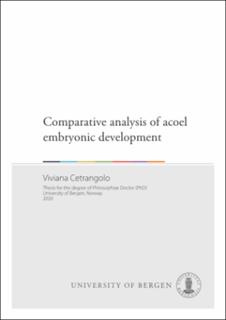| dc.contributor.author | Cetrangolo, Viviana | |
| dc.date.accessioned | 2020-09-17T12:19:52Z | |
| dc.date.available | 2020-09-17T12:19:52Z | |
| dc.date.issued | 2020-10-02 | |
| dc.date.submitted | 2020-09-15T14:07:44.246Z | |
| dc.identifier | container/50/17/ce/18/5017ce18-de08-45c7-9a26-1f6ed4c62de3 | |
| dc.identifier.uri | https://hdl.handle.net/1956/24087 | |
| dc.description.abstract | Acoels are bilaterally symmetric aquatic worms, that lack a through gut and have a single body opening to their digestive syncytium. Although they were initially placed within spiralians, because of their morphological affinities with turbellarians, acoels, together with nemertodermatids and Xenoturbella (Xenacoelomorpha), are now placed as sister group of all the remaining bilaterians (Nephrozoa = Protostomia + Deuterostomia), based on several molecular studies. This phylogenetic position gives acoels a critical role for our understanding of bilaterian evolution. Acoels show a stereotypic cleavage pattern, called duet cleavage, and also, they possess a regulative development, meaning that their embryos have the ability to adapt to perturbations of the normal development, such as the deletion of one or more blastomeres at different developmental stages. Although several studies described acoel cleavage pattern, a comprehensive study on their embryonic development, also uncovering the molecular patterning of developmental genes, is missing. Thus, to have a better understanding of the evolution of developmental traits, I analysed and compared the early embryogenesis of two acoels species, Isodiametra pulchra and Convolutriloba macropyga, focusing on the fate of the early blastomeres, on their ability to regulate (or not) cell ablations, and on the expression pattern of several developmental genes during the early cleavages. In the first part of this thesis, I provide a comprehensive study on the embryonic development of the acoel I. pulchra. The detailed fate map of the early blastomeres showed how they contribute to the germ layer derivatives and to the bilateral ground plan of these animals, while the immunostaining after the ablation of specific blastomeres showed the extent to which regulation occurs in these embryos. These data revealed similarities with the embryonic development of another acoel species Neochildia fusca, showing a general conservation of cell fates between the two acoel species, but also highlighted that the regulative potential is restricted to specific embryonic stages in the species I. pulchra. In the second part of the thesis, I analysed the spatial and temporal expression of 17 developmental genes, during the early development of the acoel C. macropyga. The expression of several ectodermal markers (dlx, emx, gata1/2/3, otx, pax2/5/8, six3/6, and nk2.1) in the micromere lineages revealed the ectodermal identity of the early micromeres, while the expression of the endomesodermal markers (gata4/5/6, fox A and foxF) in the macromere lineages revealed the endomesodermal identity of the early macromeres. The characterised molecular fates of the early blastomeres vi are consistent with the acoel fate map and provide the first early expression analysis of regulatory genes in an acoel species. This thesis expands the knowledge on the embryonic development of acoels, combining classical embryological studies, such as the fate map analyses and the perturbation experiments, with modern molecular approaches, such as whole mount in situ hybridization (WMISH). | en_US |
| dc.language.iso | eng | eng |
| dc.publisher | The University of Bergen | en_US |
| dc.relation.haspart | Paper I: Cetrangolo V., Martindale M.Q., Seaver E., Schnabel R., Hejnol A. The fate map and regulative development analyses of the acoel Isodiametra pulchra. The article is not available in BORA. | en_US |
| dc.relation.haspart | Paper II: Cetrangolo V., Hejnol A. Early blastomere identity revealed by gene expression in the acoel Convolutriloba macropyga. The article is not available in BORA. | en_US |
| dc.relation.haspart | Paper III: Martín-Durán J.M., Vellutini B.C., Marlétaz F., Cetrangolo V., Cvetesic N., Thiel D., Henriet S., Grau-Bové X., Carrillo-Baltodano A., Wenjia G., Kerbl A., Bekkouche N, Chourrout D., Gómez-Skarmeta J.L., Irimia M., Lenhardt B., Worsaae K., Hejnol A. Conservative route to extreme genomic compaction in a miniature annelid. The article is not available in BORA. | en_US |
| dc.rights | In copyright | eng |
| dc.rights.uri | http://rightsstatements.org/page/InC/1.0/ | eng |
| dc.title | Comparative analysis of acoel embryonic development | en_US |
| dc.type | Doctoral thesis | |
| dc.date.updated | 2020-09-15T14:07:44.246Z | |
| dc.rights.holder | Copyright the Author. All rights reserved | en_US |
| dc.contributor.orcid | https://orcid.org/0000-0002-4583-6181 | |
| fs.unitcode | 12-60-0 | |
